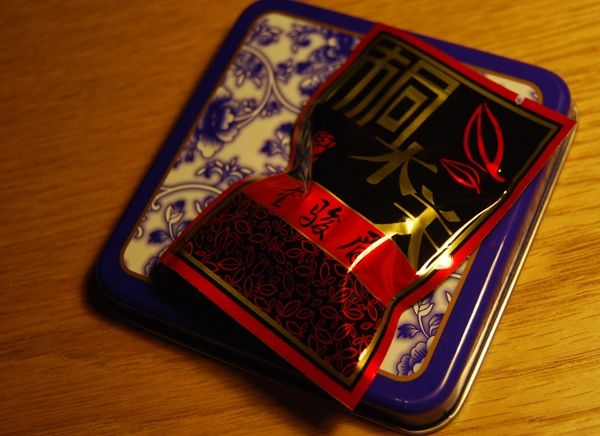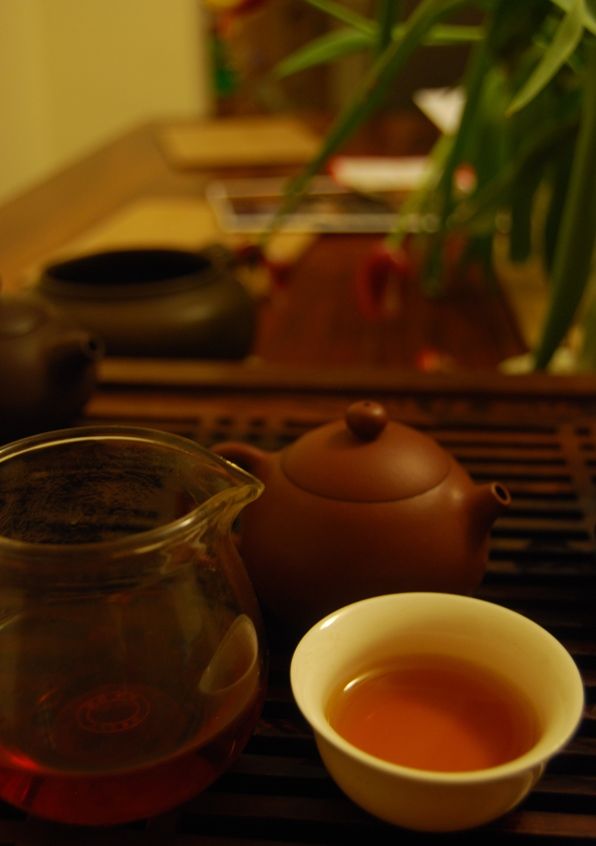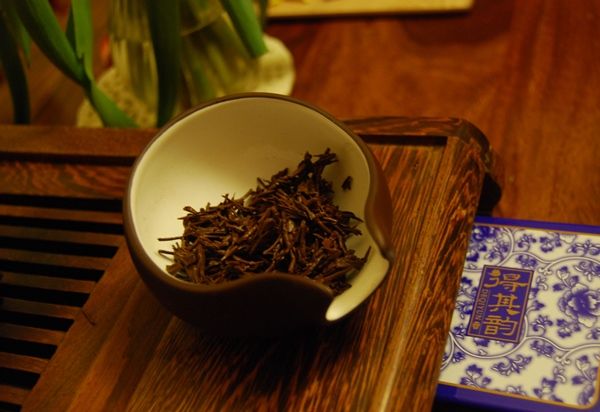Good tea can come from the most unexpected of places.
I know that writing in a second language can be a pain; some days, I wonder about my ability to write even in my first language. So, I try to help others with their writing when time allows. This particular tea was an unexpected gift given by a Chinese colleague whose abstracts for some forthcoming publications I had revised. His English was really very good, and so my additions were but minor tweaks around the edges.
His gift was this charming little box of hongcha. "This is some of the best!" he grinned.
I got excited about the tea; my dear wife was rather more interested in the pretty box, pictured above - and who can blame her? It has the style of a charming piece of porcelain. I understand that its destiny is to store something of infinitely greater value to her than tea: her critically-important supply of "Werther's Originals" toffees.
If I've recently sent you a box of samples, then you may have a packet included as shown above. It reads "Tongmuguan Jinjunmei", where Tongmuguan [tong moo gwan] is a pass in the Xingcun [shing-tsun] Village area of Chongan County, where lapsang souchong originates.
Jinjunmei means "Golden Handsome Eyebrow", and refers to the crescent-shape of the leaves, as pictured below. It is (in)famous for its rather extortionate price, and so I am very grateful to my colleague for such a gift. Indeed, it far exceeds my paltry contribution to his abstracts...
One aspect of this tea that doesn't come across in the above photograph is precisely how tiny are these leaves. They really are insy-winsy, being about 2 or 3mm in length. The "grade" must be extraordinarily high, because I don't believe that I've ever seen tea leaves this small, from any genre of tea. With pu'ercha, for example, the "grade" matters little, and cakes made entirely of small leaves may be missing out on some of the robust characteristics imparted from a robust blend of all leaf sizes. However, in hongcha and lucha, high "grade" (i.e., tiny leaves) can make a difference in terms of potency and definition of character. There is a reason, after all, why such comically small leaves attract such high buying prices, and it cannot be explained entirely by tea-buying fashions.
Drinking hongcha is an excellent excuse to dust off my beautiful Xishi pot (originally bought from Teamasters). I don't drink a huge amount of hongcha, but when I do, my little Xishi comes along with me. Such sessions are a special treat for me - I am happy with even the most rudimentary of hongcha, and so you can imagine my elation when trying such a great example.
This hongcha is not sweet. It is not the dainty, feminine affair that we might expect from its fussy little leaves. Instead, it is a masculine, robust, complexity of bass flavours wrapped up in an almost gelatinously thick soup. It reminds me of the hongcha version of good, old pu'ercha, in its texture and huigan [returning sweetness in the throat].
The little leaves continue to give thick, complex, malty, sweet infusions throughout the morning, leaving me impressed by the longevity of such small things. The comparison with good pu'ercha remains as the infusions pass, with its thickness and satisfactory grip on the throat. There are not many hongcha in this style, and it is quite an education to drink such a tipple.
This reminds me to hunt out my colleague from his laboratory, and tell him exactly how much I have enjoyed his generous gift. Of course, getting into his laboratory is a feat in itself: he is a tissue engineer, and they don't like unsterile sorts such as me, wandering in without a white coat and protective apparatus...






6 comments:
Hi,
I'm always very intrigued at just how potent and complex small leaf hong cha can be. I currently have some Tan Yang Ti Ji from Fujian on the go and it's absolutely tiny! I find I can get about 4 0-5 second steeps before I need to start pushing it a bit, a proper gong fu tea!
That pot is beautiful... must sort out myself one for hong cha as I do drink a lot of it.
Best,
Jack :)
Dear Jack,
I'm impressed by the longevity of some hongcha, as you mentioned is the case with that which you've been drinking. Perhaps more than pu'ercha, the difference between "mediocre" and "excellent" is much more obvious for hongcha in its duration; weaker leaves simply have a fraction of the content of decent hongcha. There is, of course, a tendency to make hongcha from huge plantations, which cannot help the longevity of those leaves.
You won't regret the pot, I must say; it's quite special. Stephane (the last time I checked several years ago) kept getting new examples of the same kind to sell. I believe the potter was a local Taiwanese chap.
Note to self: drink more hongcha at work. My office supplies are running low, and I keep resorting to lesser teas such as pu'ercha minituocha (!).
Toodlepip,
Hobbes
I hope you can pardon this Colonial's presumption to familiarity, but one of the things I most enjoy about reading your blog, Hobbes, is the little glimpses one gets into your domestic life; it warms my heart to imagine you and your wife ribbing one another about your respective culinary priorities.
Greeting from Bangkok, Hobbes! Just returned from another Chinese trip back to our beloved Emei Shan where the tea was fresh and . . . need I say more.
In addition, we traveled by bus from Chengdu to Langzhong (that Fengshui city in Sichuan) and then on to Xian by way of Guangyuan. In Xian, we bought some local Ziyang Mao Jian tea(紫阳毛尖) which is also process in Shanxi as well.
While negotiating for the local green tea, the owner tried to interest us in some Jin Jun Mei. We sat around for an hour visiting about the benefits of buying this tea. Of course, he was asking over a thousand Yuan for a kilo and my wife had no desire to pay that much and then have to carry it to Wutai Mountain, our ultimate destination. The tea was magnificent and looked just as yours does. Tiny little golden leaves of pure wonderful hong cha.
I did talk my wife into buying a small amount of Zheng Shan Xiao Zhong which you wrote about back in September 2010. Wow! Since both of these teas come from Fujian, I have convinced my wife that Fujian will be our next destination in China. She is a Min Nan speaker and understands the Fujian dialect so I am now in the process of planning. This planning also includes purchasing a new iPad 3 to carry all my research on the teas of Fujian and where best to buy them.
BTW, we loaded up on Emei Zhu Ye Qing and other teas from Emei via the gift channel. Almost all of our old friends presented us with the best green teas from Emei. We also picked up some Qingcheng Xue Ya tea (青城雪芽) while visiting the Du JiangYan irrigation project. This trip was supposed to be about Wutaishan but turned out to be a pretty good tea trip.
I keep up with your blog and had to tell you about how expensive the JinJunMei was in China.
Dear David,
My dear wife's taste in toffees is a very serious subject in our house. :)
Dear Cecil,
What a tremendous trip you appear to have had. It's good to read that you've encountered so much in the way of good tea, and I'm sure that a subsequent trip to Fujian will prove both interesting and tasty...
By odd chance, I just bought an iPad 3 myself, which is proving to be a remarkably useful tool for both my research and keeping track of my other computery needs. I was planning a little article on the benefits of "blogging" from a tablet, in fact.
Toodlepip,
Hobbes
I forgot about the pound of Bilochuan-type local tea we bought in a small tea shop in the ancient town. It has proven to be a really solid green tea and compares favorably with other "chuan teas" as the local seller called it.
BTW, Langzhong is a way better "ancient town" than Pingyao and those towns we visited in Anhui. We stayed at a Ming courtyard hotel for only 80 Yuan. We will definitely return to Langzhong as we did not spend enough time there.
Post a Comment